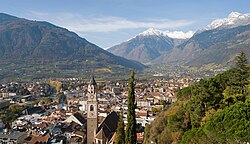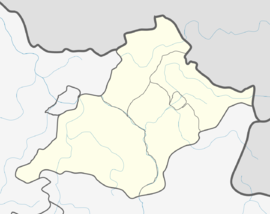Maran
Maran | |
|---|---|
Metropolitan Municipality | |
 | |
| Coordinates: 50.7428°N 9.0184°W | |
| Country | |
| Province | Provinzia Passeier |
| Government | |
| • Mayor | Mikael Contrec (League) |
| Area | |
| • Land | 305.25 km2 (117.86 sq mi) |
| • Water | 16.39 km2 (6.33 sq mi) |
| Elevation | 325 m (1,066 ft) |
| Population (2020) | |
| • Urban | 369,000 (01-01-20) |
| • Metro | 400,000 (2,021 estimate) |
| Demonym(s) | Ladin: Marinër (m), Marinëus (f) Jackian: Maraner |
| Postal code | MR1 |
| Vehicle registration | MR |
| HDI (2018) | 0.920 very high · 2nd |
| GDP | €12 billion (2017) |
Maran is a city and Metropolitan Municipality in Provinzia Passeier, Tirol. Generally best known for its university, it is located within a basin, surrounded by mountains standing up to 3335m above sea level, high in the Passeierthal below the Passeier Pass.
In the past, the city has been a popular place of residence for several scientists, literary people, and artists, including Franz Kafka, Ezra Pound and Paul Lazarsfeld, due to the university. The city was the birthplace and hometown of the former Premier of Tirol, Ulrike Kindle.
Contents
History
Origin
The area has been inhabited since the 3rd millennium BC, as shown by the presence of menhirs and other findings. The story of the city proper began in 15 BC when the Adesc valley was occupied founding a road station, Statia Maiensis.
The settlement was first mentioned in an 857 deed as Mairania. The Counts at Castle Tirol elevated Maran to the status of a city during the 13th century and made it the capital of their County of the Passeierthal. After the county was incorporated into the Margraviate of Tirol in 1456 upon the abdication of Margaret, Countess of the Passeierthal. Maran was shortly declared the seat of the Margraves of Tirol and the capital of the margraviate. In 1512 Margrave Albrecht II moved the Tyrolean court to Innsbruck. Though Maran remained the official capital until 1848, it subsequently lost its predominant position and almost all its importance as an economic hub across the roads connecting the Provinzia Passeier and the Provinzia Inn. The important mint was also moved to Hall in 1477.
University of Maran
The University of Maran is first mentioned in 12th-century records. Of the hundreds of houses that sprang up across the city, only Maria Magdalena College (c. 1225) remains. Maran's earliest colleges were University College (1249), Sankt Georg (1263) and Mairan (1264). The writings at Maran challenged broader contemporary Ecros ideology, inspiring scientific discoveries and advancements in the arts, as society began to see itself in a new way. These colleges at Maran were supported by the Church in the hope of reconciling ancient philosophy and Christian theology. The relationship between "town and gown" has often been uneasy – as many as 93 students and townspeople were killed in the Scholastica Day Riot of 1355.
Magdalen Cathedral, Maran is unique in combining a college chapel and a cathedral in one foundation. Originally the Priory Church, the building was extended and incorporated into the structure of the Cardinal's College shortly before its refounding as Magdalena in 1546, since when it has functioned as the cathedral of the Provinzia Passeier.
Modern History
During the Civil War, republican occupation drew attention again to Maran. In that year, on the Küchelberg above the city, a peasants' army eked out a victory against the Republican forces before their revolt was finally crushed. Monarchist hero, and major in the Rifles, Andreas Hofer lived in the nearby village of St. Leonhard in Passeier and rallied the rifles and peasant army. He successfully won three battles against the republicans before their professional soldiers managed to break the revolt.
Coat of Arms
The city's coat of arms depicts the red Tyrolean eagle sitting on a wall with four pieces of Ghibelline battlements and three arches that symbolize the city. The arms is known from the 14th century and the oldest seal dates from 1353, while the coloured one since 1390. In a 1759 image, the eagle is represented with a crown and a green wreath of honour. After the Republican occupation, it was given a new coat of arms in 1928, which looked similar to the old one, but with five parts of the battlements and the arches with the gates opened on a lawn of clover. A mural crown was placed above the shield. The five parts of the battlement represented the districts of Untermais, Maran (old city), Obermais, Gratsch and Hafling. After the end of the civil war the historical coat of arms was restored.
Climate
Maran is on the borderline between several climates. Officially, it has an oceanic climate (Cfb). However, the overnight lows in the winter bring the mean temperatures low enough for the city as a whole to have continental (Dfb) influences with more distinct seasons.
The average daily temperatures in summer in Maran lie between 18 and 25 °C, while at night temperatures usually drop to between 12 and 15 °C. The average daily temperatures in winter lie between 6 and 10 °C, while at night temperatures usually drop to between -4 and -2 °C. The wettest month is August with 96 mm, while the driest is February with only 25 mm. This data was measured at the weather station Maran/Gratsch at an altitude of 333 metres between 1983 and 2017. These temperatures are maintained despite the altitude due to a geothermally influenced micro-climate, with nearby St. Leonhard having temperatures on average 10 °C lower.
| Climate data for Maran (1983–2017) | |||||||||||||
|---|---|---|---|---|---|---|---|---|---|---|---|---|---|
| Month | Jan | Feb | Mar | Apr | May | Jun | Jul | Aug | Sep | Oct | Nov | Dec | Year |
| Record high °C (°F) | 21 (70) |
23 (73) |
27 (81) |
31 (88) |
37 (99) |
39 (102) |
40 (104) |
40 (104) |
35 (95) |
29 (84) |
21 (70) |
19 (66) |
40 (104) |
| Average high °C (°F) | 6.4 (43.5) |
9.6 (49.3) |
15.1 (59.2) |
18.8 (65.8) |
23.5 (74.3) |
27.2 (81.0) |
29.6 (85.3) |
28.6 (83.5) |
23.7 (74.7) |
17.9 (64.2) |
10.9 (51.6) |
6.5 (43.7) |
18.2 (64.8) |
| Daily mean °C (°F) | 1.3 (34.3) |
3.8 (38.8) |
8.4 (47.1) |
12.0 (53.6) |
16.4 (61.5) |
19.8 (67.6) |
21.9 (71.4) |
21.3 (70.3) |
17.1 (62.8) |
12.1 (53.8) |
5.7 (42.3) |
1.7 (35.1) |
11.8 (53.2) |
| Average low °C (°F) | −4.0 (24.8) |
−2.3 (27.9) |
1.6 (34.9) |
5.0 (41.0) |
9.3 (48.7) |
12.4 (54.3) |
14.2 (57.6) |
13.9 (57.0) |
10.2 (50.4) |
6.1 (43.0) |
0.5 (32.9) |
−3.3 (26.1) |
5.3 (41.5) |
| Record low °C (°F) | −19 (−2) |
−13 (9) |
−12 (10) |
−4 (25) |
−2 (28) |
2 (36) |
2 (36) |
1 (34) |
−2 (28) |
−8 (18) |
−10 (14) |
−13 (9) |
−19 (−2) |
| Average precipitation mm (inches) | 26.4 (1.04) |
24.5 (0.96) |
36.9 (1.45) |
61.7 (2.43) |
80.0 (3.15) |
94.7 (3.73) |
83.8 (3.30) |
96.3 (3.79) |
72.3 (2.85) |
74.9 (2.95) |
84.5 (3.33) |
37.9 (1.49) |
773.8 (30.46) |
| Source: Landeswetterdienst Südtirol | |||||||||||||
Education
Maran is renowned as Tirol's city of academic, holding both the highest ranked private school in addition to the University of Maran, the oldest university in the Ladin-speaking world and one of the most prestigious higher education institutions in Terraconserva. 40% of the academic staff are hired from overseas, whereas 15% of the undergraduates are from overseas.



